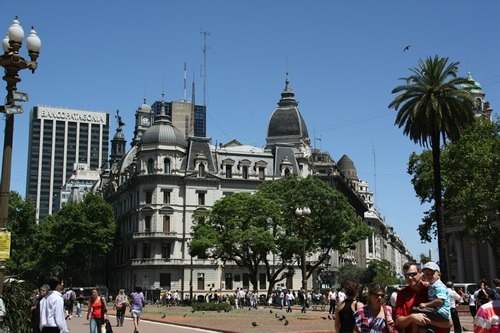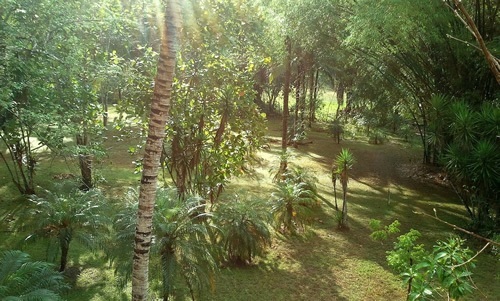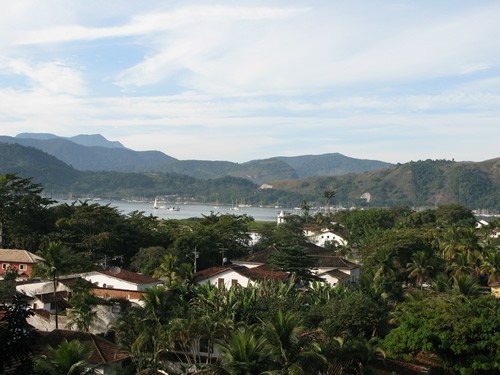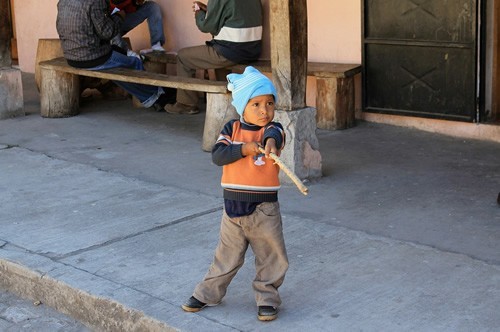Top Countries to Live Abroad in Latin America
By Molly McHugh

|
|
Women selling sauces at the central farmer's market in Sucre, Bolivia. Photo by Molly McHugh.
|
Whether traveling with children, as a couple, or solo, listed below in alphabetical order are selected spots in some of the top countries to move or enjoy an extended stay in Latin America. Many locations have extensive expatriate groups and International schools for children, such as Buenos Aires, Argentina, and Quito, Ecuador. Economically less developed areas such as Sucre, Bolivia, have much to offer, though with a smaller expat community.
The cities and towns we discuss offer a tourist infrastructure (bus transport, hostels, etc.). They are popular with travelers and excellent options for a long-term or even permanent stay. Pros and cons of each location are included to provide additional issues to consider while planning your journey or relocation. We also have links to some relevant selected websites for more detailed information. We also suggest you use sites such as Numbeo for an idea regarding the cost of living.
Argentina

|
|
A square in Buenos Aires, where many expats have moved.
|
Argentina offers many excellent options for long-term living, with expats residing throughout the country, and not only in Buenos Aires. Many fall in love with the charisma and cultural vibe of Buenos Aires, "the Paris of South America," and choose to stay permanently. It is the most accessible area to live in Argentina as an expat, with a large community that includes many foreigners and locals who speak English.
Yet, for the more adventurous, there are numerous cities and towns to settle for a while:
Yet, for the more adventurous, there are numerous cities and towns to settle for a while:
-
Mar del Plata on the Atlantic coast
-
Salta in the northwest
-
Cordoba, the second-largest city
-
Areas around the wine capital Mendoza
These areas — excluding Mendoza — are less expensive than the capital city with a more relaxed lifestyle.
Pros:
In Argentina, buying a property with only a 90-day tourist visa and living there for an extended time without going through the expense and hassle of becoming a resident is possible. You need to apply and pay for 90-day visa extensions, leave the country every six months for a day or longer, and then return and get a new tourist visa with a new stamp on your passport. Leaving and returning to the country is relatively easy and enjoyable — with Uruguay, Chile, Brazil, and Paraguay to choose from for a short visit.
Cons:
After years of being a relatively inexpensive destination, Argentina is again a rather expensive place to live and travel due to another period of increasing inflation. Many citizens buy cars and real estate in nearby countries to keep pace with the diminishing value of the national currency. Check Numbeo for current prices and the exchange rate, and be prepared to many of paper bills around.
Work and residency permits in Argentina increasingly require a lot of paperwork depending on your route; the rules are subject to change, and the country is document-driven. Contact the Embassy of Argentina in the U.S. for more information and research research work and residency permits online .
In addition, foreigners are charged on average double what a national pays to visit many tourist attractions, such as:
-
San Ignacio Mini ruins
-
Iguazu Falls
-
Riding the Patagonia Express
-
Skiing in Bariloche
The language barrier can be very tough to navigate, as the primary dialect, Rioplatense Spanish, is difficult for many to master. Argentineans who speak some English often refuse to let on they know a word of it, insisting you speak Spanish!
More Information: See Living in Argentina
Belize

|
|
Belize spans the spectrum from greenery to pure ocean life. It is a now-popular country for those wishing to move abroad.
|
If clear Caribbean waters and year-round sunshine are your priorities, Belize may be your destination. The Belize Barrier Reef is a diving and snorkeling haven. Over 180 miles long, it contains three offshore atolls (ring-like coral islands with a reef surrounding a lagoon), plus numerous sand cays (islands), lagoons, and estuaries. Marine life includes Green Moray Eels, Yellowtail Damselfish, nurse sharks, Parrot Fish, and bottlenose dolphins.
In addition to coral reefs, there are mountainous regions, savannas, and jungle lowlands to explore. When you hike, you will have 500 species of birds to search out, such as the colorful Scarlet Macaw, graceful Great Egret, and Keel-Billed Toucan — the national bird of Belize.
The main areas in the country where fearless expats who have tread before you have decided to settle are:
-
Ambergris Caye
-
Caye Caulker
-
Placencia
-
Corozal
-
The Cayo District (towns San Ignacio and Santa Elena)
Pros:
The relative proximity to the U.S. and Canada. You can drive to Belize and bring what you need to settle in comfortably rather than purchasing houseware, bedding, and other items after arrival.
Not having to learn Spanish! English is the national language of Belize and is spoken by expats and locals alike.
Cons:
In Belize, the rainy season runs from June to November, with an approximate 20% risk of hurricanes and tropical storms from July to October. Due to foreign investment and development, Belize has many environmental issues that threaten its ecosystem, such as deforestation, waste management, and the discovery of crude oil reserves in protected territory.
Some families with teenagers need to adjust, as the country is much more of a retirement destination at this time in the country's history.
Bolivia

|
|
Oranges taken off the truck at Sucre, Bolivia. Photo by Molly McHugh.
|
Many hesitate to cross into Bolivia from Ecuador, Peru, or Argentina, but there is little reason for concern. The country is as safe for travelers as most Latin American countries, and health concerns are minimal if care is taken when eating out at local restaurants or in a market. Taking a quality multi-vitamin supplement and acidophilus product can go a long way towards preventing stomach upset.
Top spots for an extended stay are Sucre, Tarija, and Copacabana:
-
Sucre is the capital city of Bolivia, a bustling hub with many local markets and a few expat-owned businesses (hostels, restaurants, and bars). A cultural center offers many art and music classes and welcomes foreign children and adult participants.
-
Tarija is tucked away in the Southeast, just three hours from the border with Argentina. The city is known for its mild climate, vineyards, and mountain scenery.
-
Copacabana is a town on the shores of picturesque Lake Atitlan, an easy three hours from La Paz. There is little to do as a traveler yet, but the area is suitable for a low-cost, relaxed stay with a fun, almost hippie vibe. There are boat tours available to Isla del Sol and other traditional islands.
Pros:
It is one of the cheapest destinations to travel or in which to live, and it is culturally unique. Approximately 60% of Bolivianos are of indigenous descent (Quechua, Aymara, Guarani, and 33 other groups).
Cons:
Bolivia restricts the time American tourists can stay in the country any given year, allowing only 90 days with no possible visa extension. U.S. passport holders must apply for a residency or another visa to live in the country for an extended time. In contrast, nationals from other countries can often extend their 90-day visa at an Immigration office or by leaving and re-entering the country.
More Information: Boliviabella.com
Brazil

|
|
Paraty, Brazil, is a popular place with expats.
|
More than the top destination for Carnival celebrations in the world, more than the location of much of the Amazon as well as so much natural beauty, Brazil is a vast, vibrant, multicultural, multiracial nation and economy gaining ground as a top relocation destination as well... for those who can afford it. Solo travelers and couples seeking an extended stay abroad should enjoy living in Brazil if they are willing to adjust to the complex culture. For families with children, bilingual International schools are located throughout the land. Still, they are primarily attended by children of diplomats and very wealthy Brazilian families.
More laid-back options to the expensive, cosmopolitan, and intense cities such as Rio de Janeiro, São Paulo, and Salvador include:
-
Paraty, a colonial gem with lovely beaches just three hours from Rio de Janeiro
-
Florianopolis, a mid-sized city (5th largest in Brazil), with beaches and surfing near the border with Uruguay and Argentina, which is quite popular
-
Curitiba, the capital of Parana in the south
Pros:
The country is immense, and the culture is famously vibrant, with an incredibly diverse population; it would be difficult to get bored in Brazil's vast and varied country.
When you arrive in Brazil, you will see big cities that are authentic ethnic melting pots.
Rio lives up to its reputation for sensuality and spectacular vistas. If flying into Rio, it can be a memorable, if terrifying, experience.
Cons:
Costs. Brazil is relatively expensive, and even if you find work, the pay will most likely be nominal compared to the cost of living. Here is an idea of the current cost of living in Brazil compared to the U.S.
The crime rate, in all forms, is notoriously high in many areas. Homeless children may accost you for money as you wander the streets on foot or via taxi. You must carefully research before traveling to new destinations and ask those who lodge you about safety issues.
In the early days, while visiting many cities, travelers are advised to take a personal guide to learn the ropes. Cities like São Paulo can be unpleasant and dangerous in some areas, and kidnapping does occur.
More Information: See Moving and Living in Brazil
Ecuador

|
|
A child in Ecuador, a people known for their hospitality and warmth, where many expats live.
|
It is a traveler's paradise and a popular long-term destination.
Ecuador has "hit the scene," so to speak, and created quite a stir. Locations for long-term living are numerous:
-
Areas near Quito, such as Cotacachi, are just 2 hours away
-
The colonial city of Cuenca
-
Tranquil Vilcabamba
-
Bahia de Carquez region on the Pacific coast
Ecuador is an excellent country to spend time studying Spanish for both children and adults. There are many K-12 bilingual International schools (English and British) in Quito. There are also many volunteer opportunities available and some English teaching jobs.
Pros:
Ecuadorians are generally good-natured and friendly, so meeting locals and making new friends is easy. Many Ecuadorians speak English, some fluently, and even non-English speakers are patient with the "gringos" who try earnestly to learn the language.
The cost of living is generally low, though property values are rising sharply due to its growing popularity as an expat destination.
Cons:
Ecuador is still financially developing, and shopping options are relatively basic, with a small selection of imported goods. Poverty is still widespread throughout the country, which can be difficult for some to see daily, even if the eighth-largest economy in Latin America has been making great strides during the past decade. For example, you will see many families living in poverty and malnourished and diseased street dogs wandering around with no one to care for them.
More Information: See Living in Ecuador
Mexico
Mexico is packed with excellent expat destinations as well as tourist hot spots.
After nine years of living and traveling in Latin America with my son (ages 5 to 14), I can attest that Mexico is the best country for children to attend school and learn Spanish. Culturally, Mexicans adore children. Adults usually address a child as they would an adult rather than ignoring them.
Local children are included in activities and welcoming of foreigners. Your child will have no choice but to constantly process the new language and attempt communication — leading to easy fluency for many expat kids. Many Mexicans speak some English and are happy to try to converse in their form of Spanglish, i.e., a mixture of English and Spanish familiar to those growing up in some Western cultures.
The variety of living environments can be overwhelming, whether you prefer sunshine and beaches or cities replete with cultural activities. Towns on the Pacific coast popular with foreigners for long-term living include:
-
San Carlos
-
Mazatlan
-
Puerto Vallarta
-
Los Cabos
Guadalajara and the nearby Lake Chapala and Ajijic are the most populated areas outside Mexico City. All attract foreigners while being full of International schools and expatriate families.
Smaller urban areas with many expats include:
Smaller urban areas with many expats include:
-
Merida
-
San Miguel de Allende
-
Oaxaca
Pros:
You can get by quickly with very little proficiency in Spanish in Mexico, especially in the touristy locations. In addition, you may choose to connect with many foreigners who live in the areas listed above part- or full-time.
The country is an excellent choice for children to learn Spanish, with private bilingual schools nationwide.
Cons:
According to the U.S. government, Mexico is large, and some areas are not considered safe for tourists, so care must be taken when driving through parts of the country and visiting off-the-beaten-track destinations. Editor's note: we have an article by an experienced expat and traveler that debunks some myths about the danger to tourists in Mexico relative to the U.S, for example.
More Information: See Living and Moving to Mexico
Molly McHugh spent nine years on the road with her son, largely in South America, engaging in educational and long-term travel.
|
